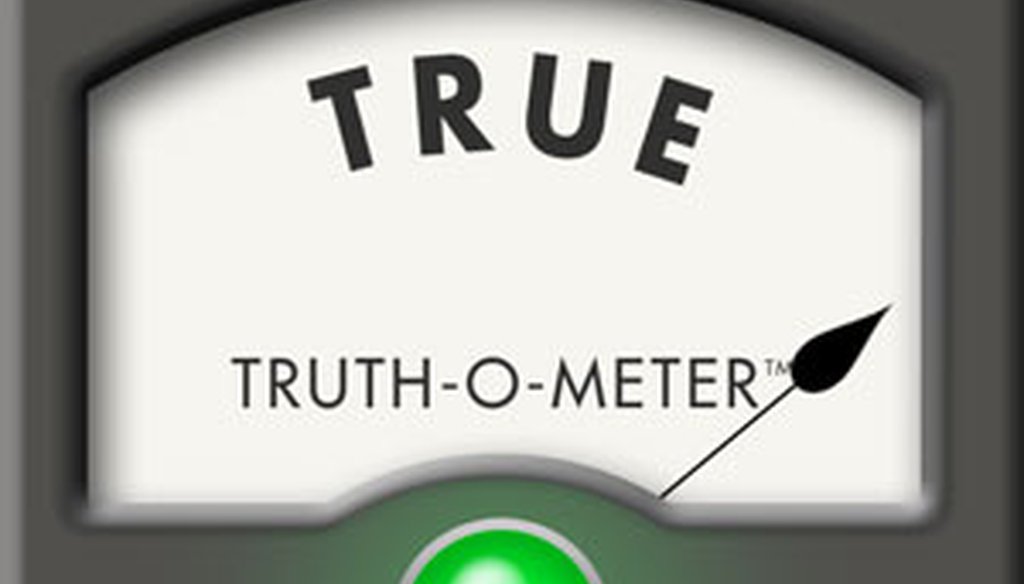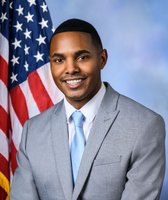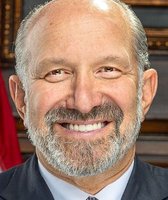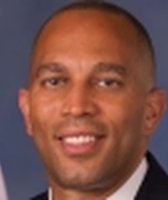Stand up for the facts!
Our only agenda is to publish the truth so you can be an informed participant in democracy.
We need your help.
I would like to contribute

We've published more than 6,000 Truth-O-Meter fact-checks since we launched five years ago.
A few months ago, we noted a decline in truth-telling during the 2010 campaign -- to a level so low that we felt obliged to rate the entire election Barely True.
But let's look at the bright side: They occasionally said things that were true.
Below are five statements we rated True during 2010, most having to do with policy questions rather than campaign rhetoric -- and all of which, to one degree or another, surprised us. (We previously published a separate rundown of True statements made during the 2010 campaign.)
• Sen. Orrin Hatch, R-Utah: The health care bill will subsidize families of four that make more than $80,000 a year.
In an interview on CNN's State of the Union, Hatch said of the newly passed health care law, "Do you realize they're going to subsidize families that make over -- families of four that make over $80,000 a year?"
We knew that under the new law, subsidies will be available to Americans who buy insurance on exchanges -- the virtual marketplaces for health plans that are scheduled to be operational in 2014. The exchanges are designed to serve people who do not already have insurance through their employer and who are not covered by a government program such as Medicare or Medicaid.
Still, we were surprised to hear that people earning as much as $80,000 could end up being subsidized. So we decided to look deeper into the numbers.
Sign up for PolitiFact texts
The subsidies will operate on a sliding scale, benefiting those who earn between 133 percent and 400 percent of the federal poverty level. Officially, the federal poverty limit for a family of four is $22,050, and 400 percent of that amount would be $88,200. That means that many people eligible for the subsidies will actually earn more than the national median income for married couple familes -- $73,010.
On the other hand, how affluent a family making $88,200 actually is depends on where you live. In four states, $88,200 is actually below the median income for a family of four -- in New Jersey ($94,441), Maryland ($94,017), Connecticut ($93,821) and Massachusetts ($89,347). By contrast, $88,200 is well above the median income in Arkansas ($52,185), Mississippi ($52,992) and Hatch's state of Utah ($63,586). The bill does not include any mechanism to even out such geographic variations.
So, Hatch wasn't just right, he actually lowballed the figure a bit. We rated his statement True.
• Rep. Carolyn Maloney, D-N.Y.: Democratic presidents "have been considerably more effective at creating private-sector jobs."
Before looking into this claim, we were skeptical that private-sector job-creation statistics would track strongly with one party or the other. But the data was surprisingly consistent.
Our full methodology is available in the original item we wrote, but here's the list we came up with -- the 12 most recent presidents, ranked in descending order of private-sector job growth per year in office:
Lyndon B. Johnson (Democrat): increase of 3.88 percent a year
Jimmy Carter (Democrat): increase of 3.45 percent a year
Harry S. Truman (Democrat): increase of 2.95 percent a year
Bill Clinton (Democrat): increase of 2.86 percent a year
Ronald Reagan (Republican): increase of 2.46 percent a year
Richard M. Nixon (Republican): increase of 2.16 percent a year
John F. Kennedy (Democrat): increase of 2.03 percent a year
Gerald R. Ford (Republican): increase of 0.86 percent a year
Dwight D. Eisenhower (Republican): increase of 0.50 percent a year
George H.W. Bush (Republican): increase of 0.40 percent a year
George W. Bush (Republican): increase of 0.01 percent a year
Barack Obama (Democrat): decrease of 3.0 percent a year
All told, the Democrats averaged 2.03 percent annual job growth, compared to 1.07 percent for Republicans -- almost twice as high for the Democrats. And based on some quick calculations he did, Brookings Institution economist Gary Burtless told us that the U.S. working-age population actually grew slightly faster under Republican presidents, making the Democratic accomplishment even more impressive.
As Yale political scientist David Mayhew pointed out, conclusions drawn from a relatively narrow data set -- in this case, just 12 postwar presidencies -- need to be taken with a grain of salt, and in our analysis, we discussed several factors that could have explained the difference that have nothing to do with the quality of presidential leadership. But while we acknowledged that the significance of this pattern was open to question, the facts were clear: Maloney was correct.
• New York City Mayor Michael Bloomberg (I): "We can prevent terror suspects from boarding an airplane, but the FBI doesn't have the power to block them from buying dynamite or an AK-47."
In the wake of a foiled car bomb attempt in Times Square, New York City Mayor Michael Bloomberg came to Washington on May 5, 2010, to lobby for legislation he hopes will keep guns out of the hands of terrorists. "It's amazing but true," Bloomberg wrote in an op-ed for the Huffington Post the same day. "We can prevent terror suspects from boarding an airplane, but the FBI doesn't have the power to block them from buying dynamite or an AK-47."
We wondered whether that could possibly be true.
A report from the U.S. Government Accountability Office showed that Bloomberg was right: "Membership in a terrorist organization does not prohibit a person from possessing firearms or explosives under current federal law."
That doesn't necessarily mean that those purchases go unnoticed by the feds. When a person on the "Known or Appropriately Suspected Terrorists" list applies to buy a firearm, it sets off notifications to various law enforcement and counterterrorism intelligence groups, according to the FBI assistant director Daniel D. Roberts' testimony before the Senate Committee on Homeland Security and Governmental Affairs on May 5, 2010. But if no "federally prohibitive information" is uncovered, the purchases are allowed to proceed.
Whether the law makes sense is a political matter. But there is no dispute that the FBI currently does not have the power to block suspected terrorists from buying dynamite or an AK-47, as Bloomberg said, unless they have some other disqualifying factor such as a felony conviction on their record. And, in fact, people on the terror watch list have been able to purchase firearms or explosives more than a thousand times in the past six years, federal statistics show. So we rated Bloomberg's statement True.
• Republican National Committee Chairman Michael Steele: The Republican Party "fought very hard in the '60s to get the civil rights bill passed, as well as the voting rights bill."
In an interview on ABC's This Week, Republican National Committee chairman Michael Steele -- his party's first African-American chairman -- made a point of arguing that his party had been on the forefront of civil rights. "Our party has always had a strong view on this issue," Steele told ABC's Jake Tapper. "We fought very hard in the '60s to get the civil rights bill passed as well as the voting rights bill."
We decided to see whether Steele was correct.
The Civil Rights Act -- which is best known for barring discrimination in public accommodations -- passed the House on Feb. 10, 1964 by a margin of 290-130. When broken down by party, 61 percent of Democratic lawmakers voted for the bill (152 yeas and 96 nays), and 80 percent of the Republican caucus supported it (138 yeas and 34 nays).
When the Senate passed the measure on June 19, 1964, -- nine days after supporters mustered enough votes to end the longest filibuster in Senate history -- the margin was 73-27. Better than two-thirds of Senate Democrats supported the measure on final passage (46 yeas, 21 nays), but an even stronger 82 percent of Republicans supported it (27 yeas, 6 nays).
The primary reason that Republican support was higher than Democratic support -- even though the legislation was pushed hard by a Democratic president, Lyndon B. Johnson -- is that the opposition to the bill primarily came from Southern lawmakers. In the mid 1960s, the South was overwhelmingly Democratic -- a legacy of the Civil War and Reconstruction, when the Republican Party was the leading force against slavery and its legacy. Because of this history, the Democratic Party in the 1960s was divided between Southern Democrats, most of whom opposed civil rights legislation, and Democrats from outside the South who more often than not supported it.
This pattern showed clearly in the House vote. Northern Democrats backed the Civil Rights Act by a margin even larger than that of Republicans -- 141 for, just four against -- while Southern Democrats were strongly opposed, by a margin of 11 yeas to 92 nays.
When the Voting Rights Act hit the floor in 1965, the vote results mirrored those of the Civil Rights Act. In the House, the measure passed by a 333-85 margin, with 78 percent of Democrats backing it (221 yeas and 61 nays) and 82 percent of Republicans backing it (112 yeas to 24 nays).
In the Senate, the measure passed by a 77-19 vote, with 73 percent of Democrats and 94 percent of Republicans supporting the bill.
Several Republicans took leading positions in sheperding the bills to passage, including Rep. Charles (Mac) Mathias of Maryland and Sen. Jacob Javits of New York. A key to Senate passage of the Civil Rights Act was winning the support of Senate Minority Leader Everett Dirksen, R-Ill. While Dirksen had some reservations with certain provisions of the Civil Rights Act, "key parts of the bill were worked out in Dirksen"s office in the evenings," said U.S. Senate Historian Donald A. Ritchie. Other midwestern Republicans followed Dirksen's lead and supported the bill. Once the filibuster was broken, Time magazine put Dirksen on its cover.
It's true that the party's 1964 presidential nominee, Barry Goldwater, voted against the Civil Rights Act and stuck to that position during the campaign (which he lost to Johnson in a landslide). But on the whole, the degree of Republican support for the two bills actually exceeded the degree of Democratic support. That was enough to earn Steele a rating of True.
• MSNBC host Rachel Maddow: "The overall fact about illegal immigration is that it's not actually getting worse."
Judging by the campaign ads and rhetoric about the dangers of illegal immigration, one would assume that the number of undocumented immigrants is rising. But on her August 2, 2010, show on MSNBC, liberal host Rachel Maddow said that "the overall fact about illegal immigration is that it's not actually getting worse."
When we checked out Maddow's claim, we actually found that she was right -- though not using the statistics she held up during her show.
She showed a graph displaying border apprehensions by year, but experts we spoke to advised us that those numbers could reflect improved avoidance techniques by those trying to cross the border. Fortunately for Maddow, other statistics do bear out her claim.
Using monthly Census data, the Center for Immigration Studies estimated that "the illegal population declined 13.7 percent (1.7 million) from a peak of 12.5 million in the summer of 2007 to 10.8 million in the first quarter of 2009." This is similar to DHS estimates, which also saw a downward trend from a peak of 11.8 million in 2007 to 10.8 million in 2009.
It's important to note that the decline in the number of undocumented workers may have less to do with a more secure border and more to do with a less secure economy in the U.S. Potential border-crossers "know they can't get jobs because of the economic downturn," said Jeff Passell, senior demographer for the Pew Hispanic Center. Passel said that his data shows that "from 1992 through about 2004 the U.S. employment rate and the volume of the numbers of Mexicans coming to the U.S. are almost perfectly correlated." This seems to indicate that illegal immigration inflows are primarily related to economic considerations.
So if the unemployment rate drops and more jobs are available, it's likely that more people will risk crossing the border, reversing the trend we see now. But for the time being, the numbers in both counts are going down. So Maddow's statement was True.
Our Sources
See Truth-O-Meter items


































